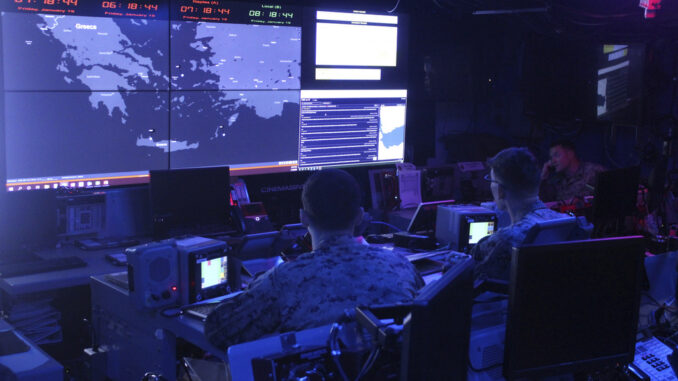

ON BOARD THE USS BATAAN — When attacks with missiles and drones surged in the Red Sea late last year, crewmembers of the USS Bataan worked round the clock to make sure they were shot down before reaching passing merchant vessels.
Weeks later, they are still perfecting that operation in training and simulations, along with a dozen other scenarios, despite moving north to the Mediterranean where commercial marine traffic is at little risk.
The U.S. Navy is reshuffling its warship deployment in the Middle East to maintain dominance in the region – now eyeing the longer haul as concerns mount that Israel’s war on Hamas in Gaza could set off a regional conflict.
An amphibious warship, the Bataan is a multi-deck assault vessel jammed full of armored vehicles and military hardware with a lower bay that can take on water to release landing craft directly into the sea.
The ship is now leading the United States’ task force in the eastern Mediterranean, following the Navy’s newest aircraft carrier, the USS Gerald Ford, which was sent home at the New Year.
The Bataan and two support ships, the USS Mesa Verde and USS Carter Hall, have a combined force of nearly 2,500 Marines and sailors.
Marine Lt. Col. Jeremy Hawkins, a senior planner on the task force, says the makeup of the multi-role naval force is ideal for the complex nature of the conflict and for related regional sources of tension.
“We’re able to operate really autonomously in international waters and airspace. And so it gives us a lot of freedom of operations,” he said. “We’re floating on a piece of America, wherever we’re at.”
As he spoke, a “jump jet” AV-8B Harrier roared off the deck overhead, launching a night flight designed to maintain readiness for pilots and support staff.
Now in its 15th week, the war in Gaza continues to pile tension onto multiple flashpoints in the wider region, many involving militant groups supported by Iran, including Hezbollah in Lebanon and the Houthi movement in Yemen.
“The deployment of the USS Bataan to the eastern Med is meant to do two things,” said Gregory Aftandilian, a senior lecturer at the School of International Service, at the American University in Washington, D.C.
“It’s to deter Hezbollah from increasing its missile attacks against Israel, which has the potential to lead to a wider war, and to bolster the US naval presence in the Red Sea to hopefully deter the Houthis from launching more attacks on shipping in that body of water.”
The United States assembled a powerful concentration of naval forces in October, sending two aircraft carriers to the Middle East after Hamas attacks in Israel triggered the ongoing offensive in Gaza.
The Bataan was sailing toward the eastern Mediterranean Friday after taking part in live-fire exercises with NATO-member Greece on the country’s mainland.
At sea for six months, crew members have had their deployment extended because of the crisis, the U.S. military relying on the fast deployment skills of the 26th Marine Expeditionary Unit, based in North Carolina, combined with the Navy.
That means snipers and demolition experts spend their days in close quarters with ICU doctors and intelligence officers.
They all live connected by a maze of windowless passageways, many using remote corners to carve out a workout space or using the incline of deck ramps to exercise.
Fourteen floors of living quarters and administrative areas are wrapped around a helicopter hanger and hospital positioned in the center of the 843-foot ship.
Attack helicopter pilot Marine Capt. Sam Peters says he hopes to return home soon to his home in Valdosta in the southern U.S. state of Georgia but realizes his stay on the ship could again be extended.
“To be completely honest, we’re constantly training and constantly ready to respond to crises, I don’t think our mission has really changed,” he said. “I would say, the difference (after coming to Greece) is that the food is a little bit better.”



